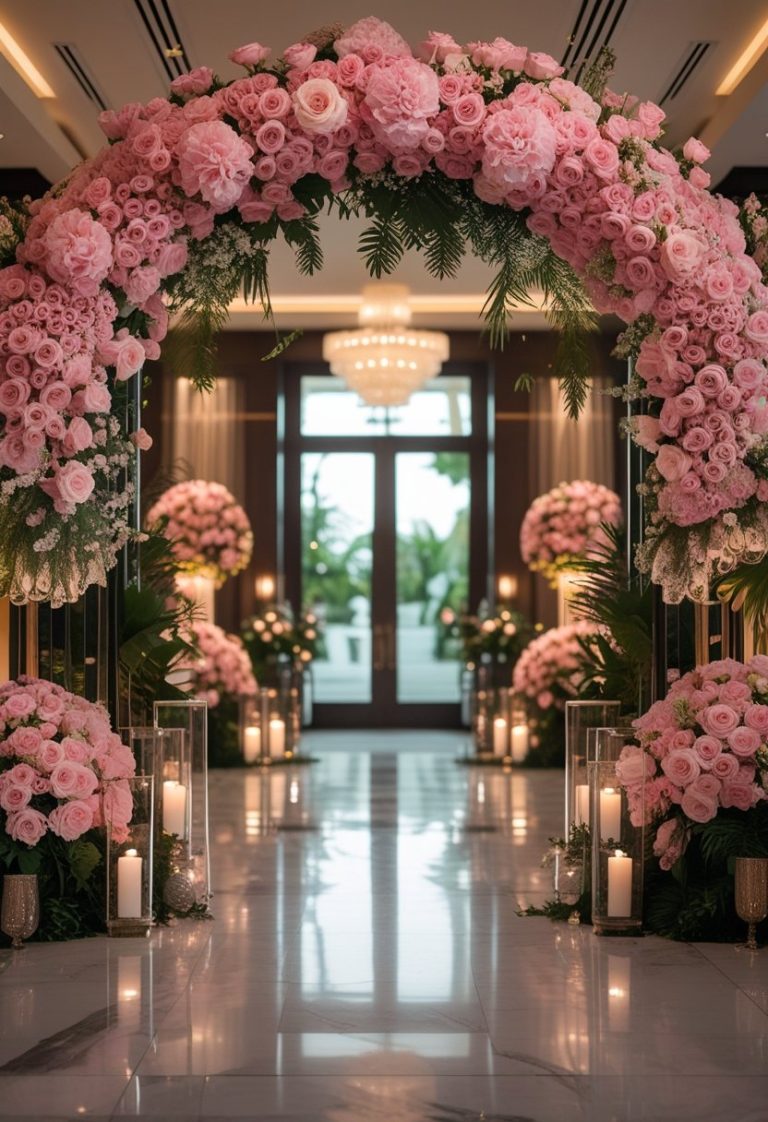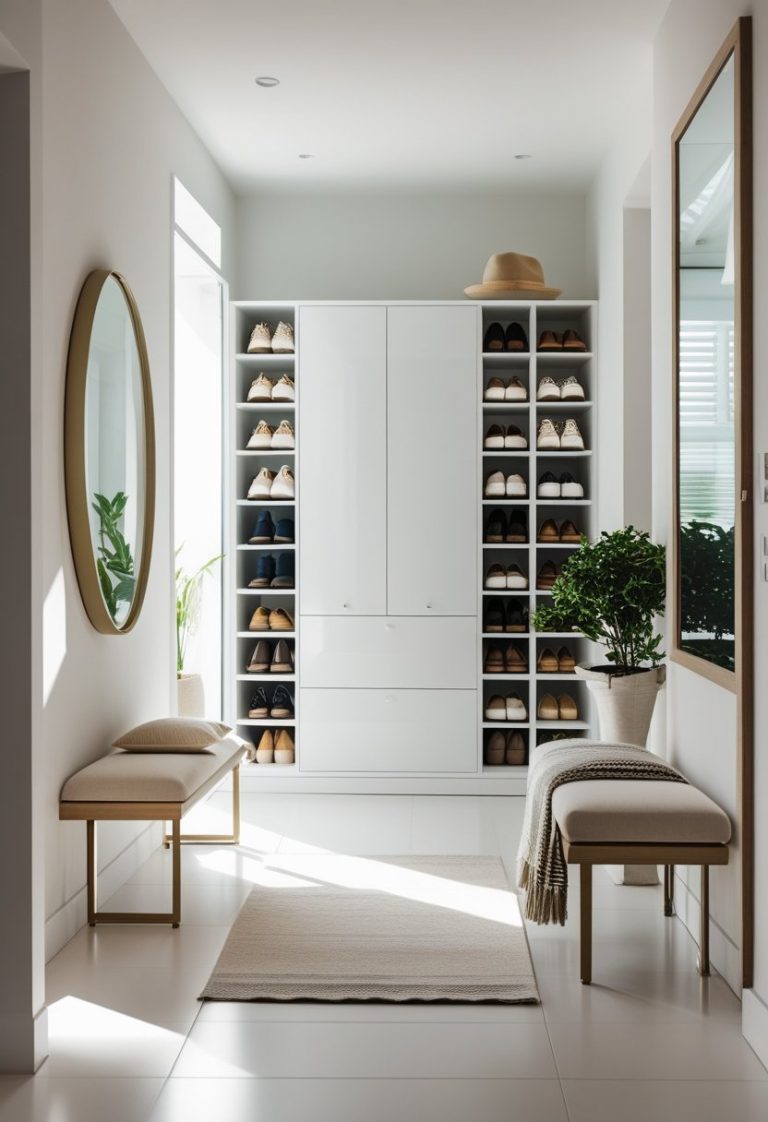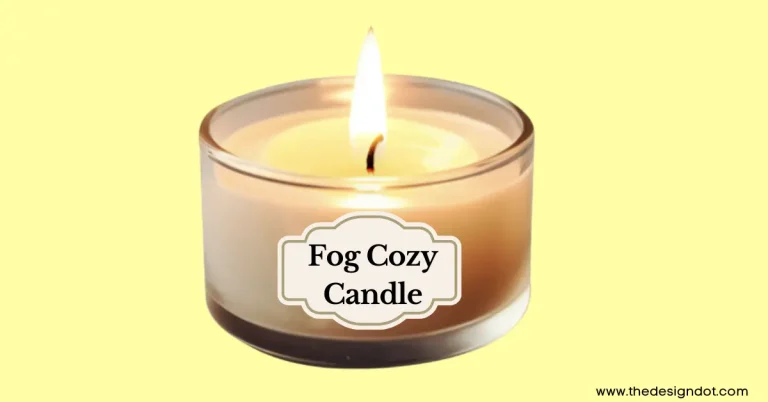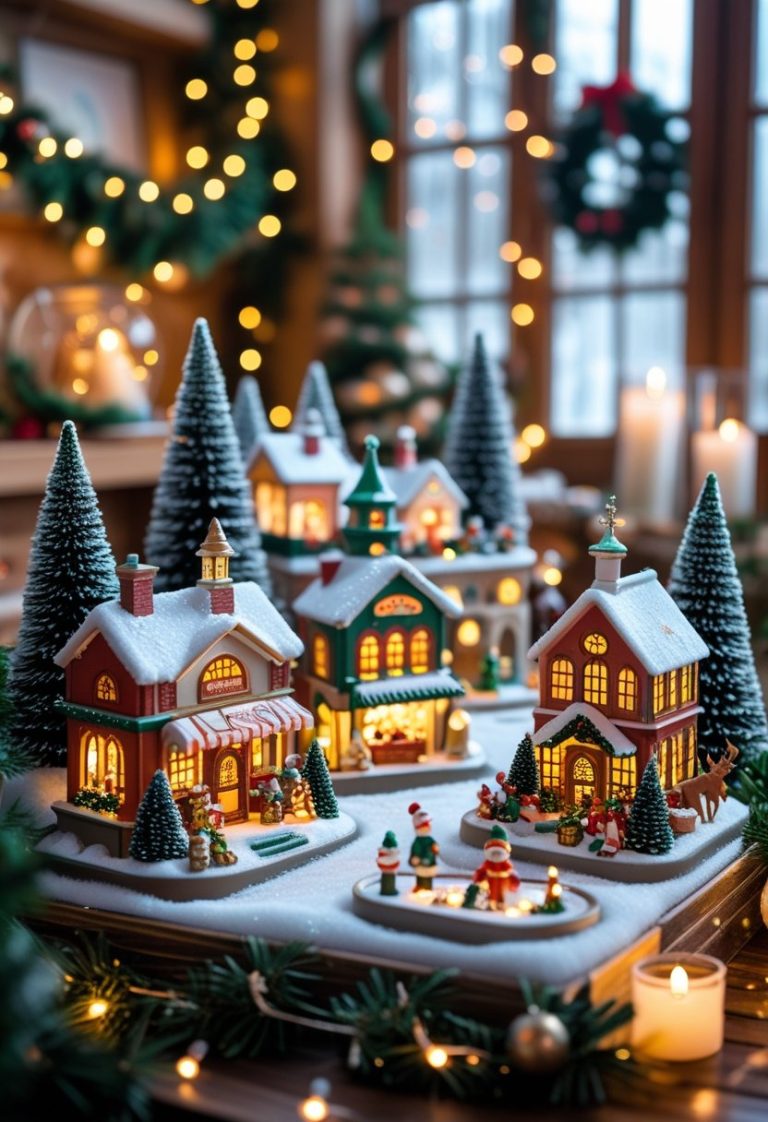Warm Boho Entryway Ideas with Plants & Natural Light Decor”
Creating a warm boho entryway centered around plants and natural light offers a simple way to elevate a home’s atmosphere. This style combines woven textures, organic wood accents, and abundant greenery to foster a welcoming, earthy vibe. Incorporating natural light and indoor plants enhances the calm, eco-chic aesthetic while maintaining the clean, minimal lines inspired by Scandinavian design.
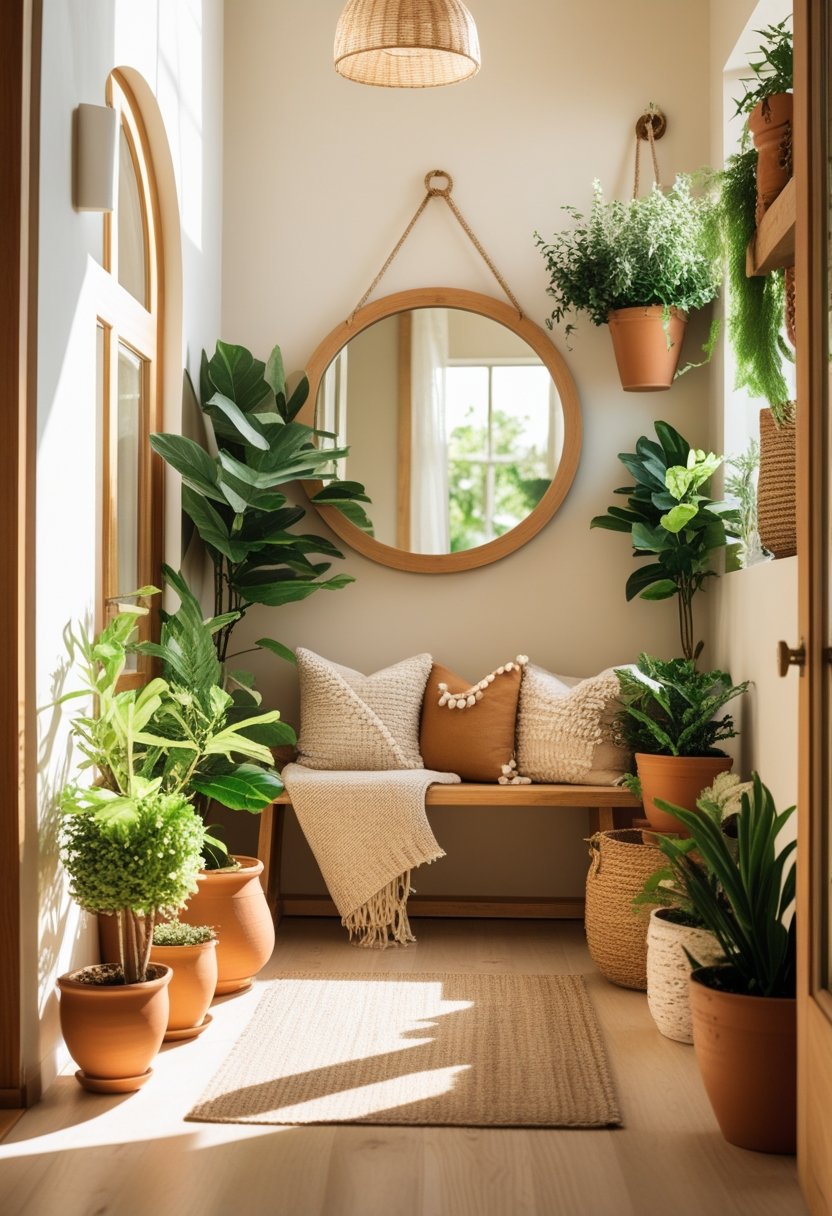
Using neutral tones and natural materials creates a soothing environment that balances texture with simplicity. Woven baskets, wooden benches, and lush plants bring warmth and a sense of nature indoors, making the entryway a reflection of both style and sustainability. The result is an inviting space that feels fresh, airy, and effortlessly cohesive.
This approach suits anyone seeking a stylish, functional entrance that reflects a love for natural elements and understated design. It shows how combining greenery with carefully chosen natural light and boho-inspired decor can transform an ordinary hallway into a harmonious living space.
Defining a Warm Boho Entryway
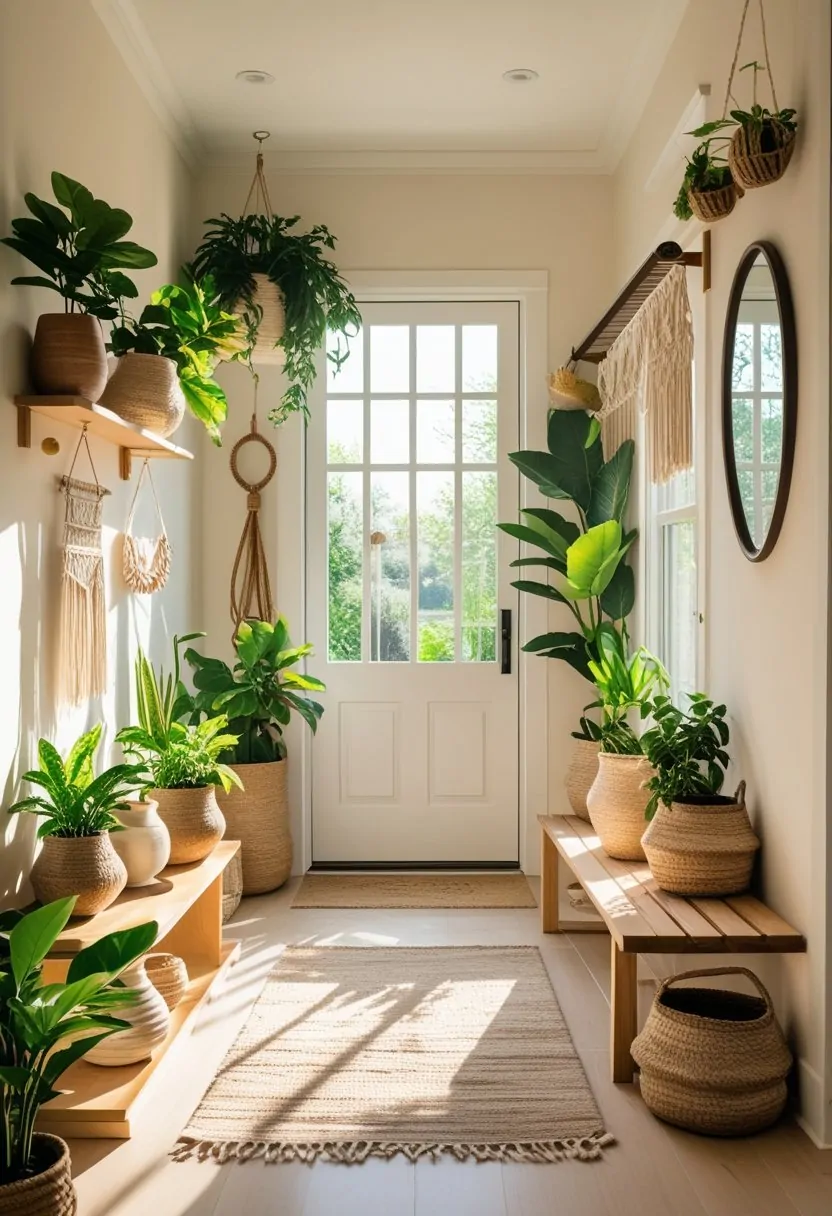
A warm boho entryway combines layered textures, natural elements, and a balanced simplicity. It offers a cozy yet stylish space that welcomes guests while reflecting a curated blend of organic and modern aesthetics.
Core Elements of Modern Boho Style
Modern boho style centers on a relaxed, eclectic mix of patterns and materials. Key components include woven rugs, rattan or wicker furniture, and textiles featuring layered patterns. Earth tones like ochre, rust, and muted greens play a significant role in grounding the space.
Functional decor such as baskets and macramé wall hangings add texture without clutter. These elements convey a lived-in, artistic atmosphere without relying on bold color contrasts. Lighting tends to be soft and warm, enhancing the inviting feel.
Role of Plants and Organic Textures
Plants are essential to a warm boho entryway, bringing life and fresh air into the space. Varieties like pothos, snake plants, and ferns work well indoors, providing varying shapes and shades of green that complement natural wood and woven textures.
Organic textures like jute rugs, wooden benches, and linen cushions create tactile interest. These materials emphasize authenticity and sustainability, reinforcing the eco-conscious appearance of the entryway. Together, plants and textures build a sense of calm and connection to nature.
Influence of Scandinavian Minimalism
Scandinavian minimalism shapes the warm boho entryway by prioritizing simplicity and natural light. Clean lines and uncluttered surfaces avoid overwhelming the space while allowing key decorative elements to stand out.
Neutral color palettes emphasize whites, beiges, and soft grays, acting as a subtle backdrop. The integration of large windows or mirrors boosts natural light, making the entryway feel airy and open. This minimalist influence ensures the space remains functional yet aesthetically appealing.
Optimizing Natural Light in Your Entryway
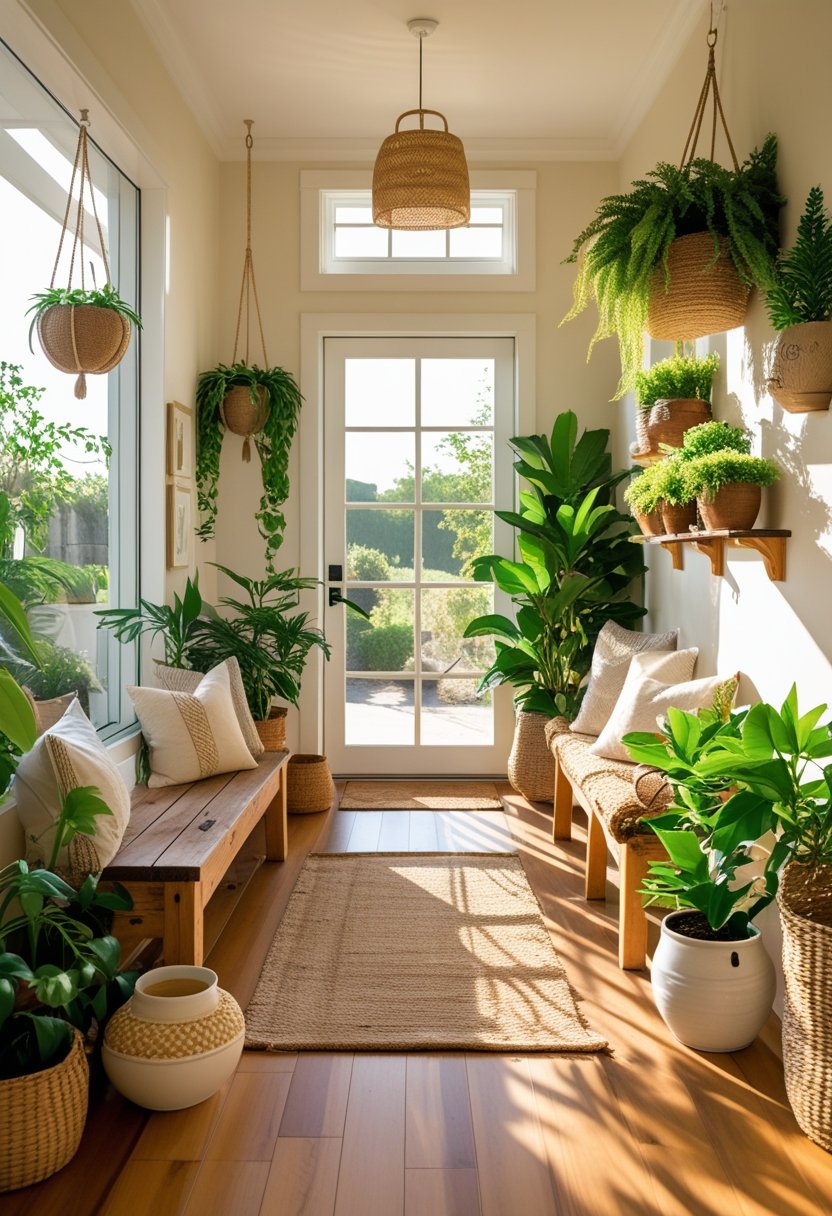
Maximizing natural light in the entryway involves smart choices about window treatments, mirror placement, and paint color. Each element plays a crucial role in reflecting and enhancing daylight to create a bright, welcoming space.
Choosing the Best Window Treatments
Light-filtering curtains or sheer panels allow sunlight to enter while maintaining privacy. Avoid heavy drapes or dark fabrics that block natural light.
Materials like linen or cotton with neutral tones blend well with boho decor and support light diffusion.
Blinds with adjustable slats are also practical, letting occupants control the amount of daylight without sacrificing style.
Positioning window treatments higher and wider than the window frame can increase the sense of height and openness.
Arranging Mirrors for Maximum Brightness
Mirrors amplify natural light by reflecting it throughout the entryway.
Place a large mirror opposite or adjacent to a window to bounce sunlight deep into the space.
Decorative mirrors with natural wood or woven frames align well with boho aesthetics.
Avoid overcrowding with too many small mirrors; one or two well-placed, larger mirrors are more effective.
Selecting Light Paint Colors
Light paint colors enhance light reflection and brighten the entryway.
Choose shades like soft white, pale beige, or muted greys with warm undertones to complement natural wood and plant greenery.
Avoid stark or glossy whites that clash with earthy boho elements.
Matte or eggshell finishes reduce glare while maintaining brightness, contributing to a calm yet luminous atmosphere.
Incorporating Indoor Plants for a Lively Welcome
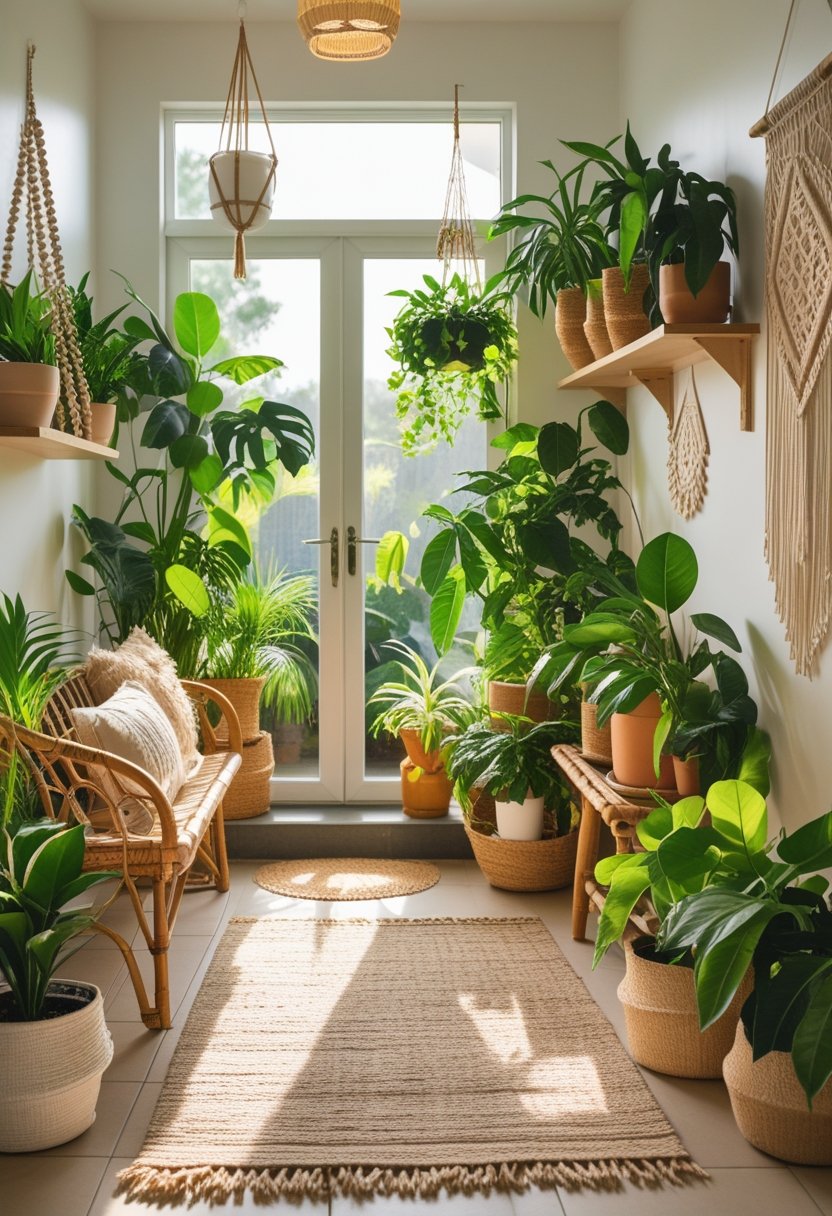
Plants bring immediate freshness and texture to an entryway while complementing natural light and woven decor. Selecting the right plants, arranging them thoughtfully, and understanding their care needs ensures a vibrant, inviting space that remains healthy and attractive.
Best Plant Types for Entryways
Low-maintenance plants with tolerance for varying light levels are ideal for entryways. Snake plants, pothos, and ZZ plants thrive in indirect or low light and require minimal watering, making them practical choices.
Fiddle leaf figs and rubber plants offer visual impact with their large leaves but need moderate, consistent light. Smaller options like succulents work well on tables or shelves where bright light is present.
Choosing plants with diverse leaf shapes and textures enhances the boho aesthetic and keeps the arrangement dynamic. Prioritize species resilient to occasional drafts or temperature changes common near doorways.
Creative Display and Arrangement Ideas
Layer different pot heights using wooden stands, woven baskets, or terracotta vessels to blend natural materials with greenery. Hanging plants like English ivy or trailing pothos add vertical interest without crowding floor space.
Group plants in clusters rather than lining them up to create a natural, relaxed feel. Combine a statement floor plant with tabletop arrangements to balance scale.
Incorporate accessories such as macramé hangers or reclaimed wood shelves to reinforce the boho vibe. Rotate plants occasionally to keep the display fresh and balanced under changing light.
Caring for Plants in Low-Light Spaces
Maintaining healthy plants in dim entryways involves strategic placement and lighting adjustments. Position plants close to windows or use mirrors to reflect natural light deeper into the space.
Water sparingly, as low light reduces evaporation rates; overwatering is a common issue. Choose plants tolerant of low light to reduce stress and avoid sudden exposure to harsh sunlight.
Regular dusting of leaves improves photosynthesis and appearance. Supplementing with a small grow light can support thriving greenery when natural light is insufficient.
Woven Textures and Organic Wood Accents
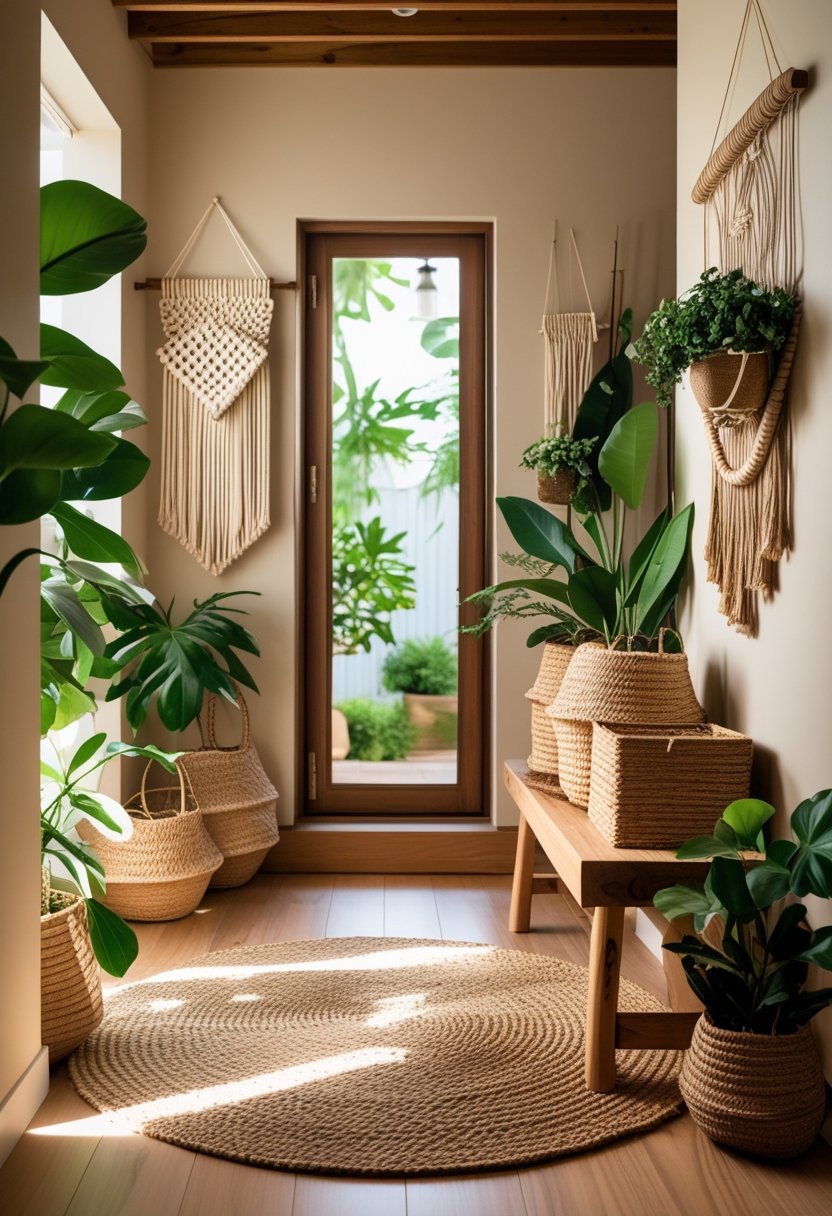
Woven materials like rattan and jute add tactile warmth and visual depth to a boho entryway. Organic wood accents bring natural character while maintaining a clean, Scandinavian-inspired look. Together, these elements create an inviting yet balanced space with layered textures and earthy tones.
Uses for Rattan and Jute
Rattan is versatile and durable, commonly used for furniture pieces such as benches or chairs in an entryway. It provides a natural pattern that complements neutral palettes and enhances the boho aesthetic without overpowering the space.
Jute works well for rugs, wall hangings, and baskets. Its coarse weave creates texture and grounds the area with an earthy feel. Placing a jute rug near the door adds softness underfoot while maintaining an organic look.
Both materials are lightweight and eco-friendly, making them functional and sustainable decor choices. They pair well with indoor plants by echoing natural elements through fiber and form.
Integrating Wooden Accessories
Wooden accents contribute warmth through materials like reclaimed timber or smooth, untreated hardwood. Small wooden trays, coat hooks, or frames provide functional details that align with rustic and minimalist design principles.
Using wood with visible grain and imperfections adds authenticity to the space. Slatted wood benches or simple floating shelves can serve both practical uses and aesthetic cohesion.
It’s important to balance wood tones with the rest of the entryway’s color scheme. Light or medium shades work best with neutral walls and woven textiles, ensuring the space feels open and airy.
Combining Textures for Visual Interest
Layering multiple textures such as woven fibers, raw wood, and soft textiles enriches the entryway’s look. Combining a rattan chair with a jute rug and wooden baskets creates varied surfaces that catch the eye without clutter.
Contrast smooth wood finishes with rougher woven elements to avoid uniformity. Adding cushions or throws in natural fabrics like linen or cotton enhances comfort while contributing subtle texture shifts.
A practical way to mix textures is through a curated grouping on a bench or shelf, balancing function with style. This approach supports the core boho principle of warmth through eclectic yet intentional layering.
Selecting Eco-Chic Decor in Neutral and Earthy Tones
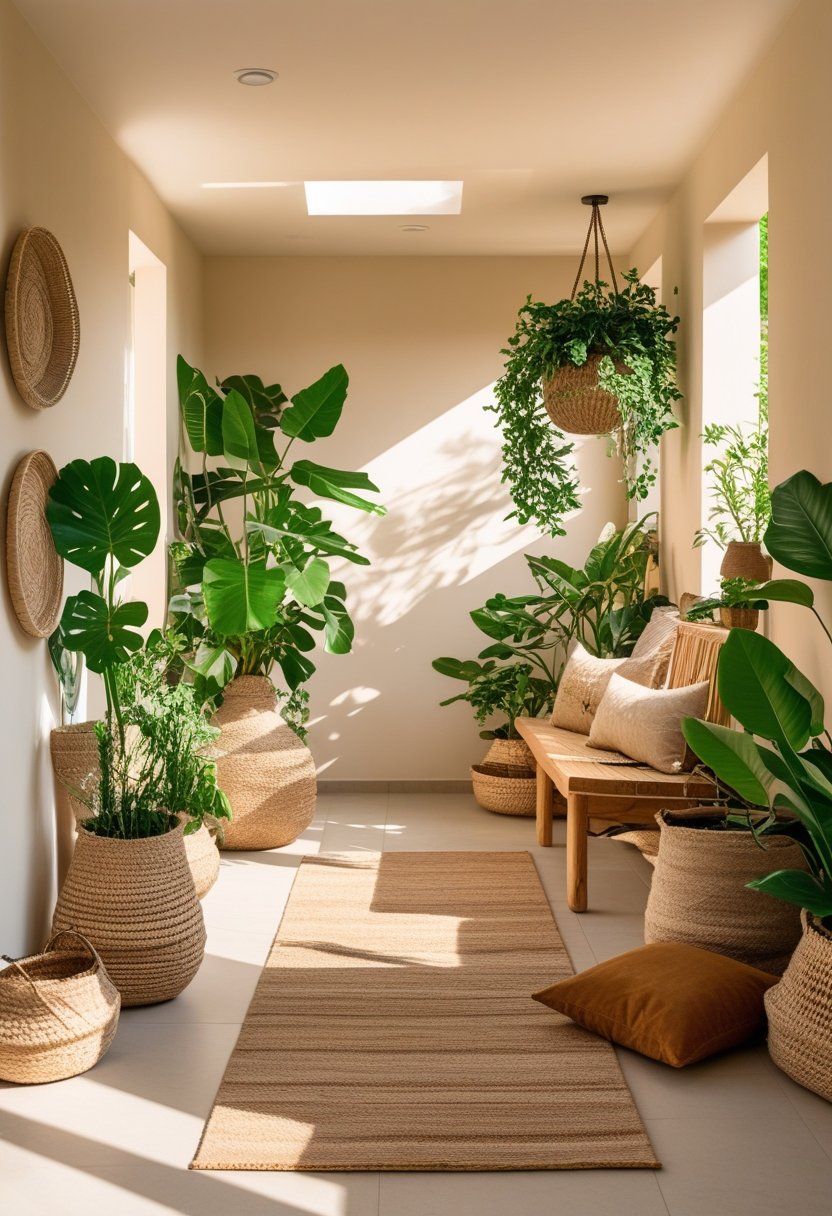
Choosing decor that blends sustainability with soft, natural colors helps create a calm, inviting entryway. The right materials and color choices set a foundation for warmth and simplicity, enhancing the boho vibe without clutter. Both the texture and palette play key roles.
Sustainable Materials and Accessories
Eco-chic decor focuses on materials that have minimal environmental impact and age well over time. Organic wood, bamboo, rattan, and recycled metals are common choices trusted for durability and style. These materials bring natural textures that add depth and comfort.
Accessories such as woven baskets, hand-loomed rugs, and ceramic planters should demonstrate craft quality and sustainability. Selecting pieces made with renewable resources or techniques like hand-weaving supports ethical manufacturing. Avoid heavily processed or synthetic items.
Maintaining a minimalist approach ensures that each eco-friendly piece stands out. This keeps the entryway open and emphasizes thoughtful, purposeful decor. Items that balance practicality with aesthetics—like wooden benches or natural fiber hooks—work best.
Styling with Earth-Inspired Palettes
Using earthy tones such as beige, clay, taupe, and soft gray sets a soothing backdrop. These colors replicate natural landscapes and foster a grounded, serene atmosphere in the entryway.
Neutral hues function as a canvas, allowing textures and greenery to become focal points. Layering colors in varying shades—like a sand-toned wall paired with charcoal wood accents—creates subtle contrast and interest.
Incorporating these palettes across textiles, pottery, and furniture achieves harmony. The resulting space feels airy yet warm, ideal for a welcoming boho entryway that embraces simplicity and nature without overwhelming the senses.
Arranging Functional and Inviting Entryway Layouts
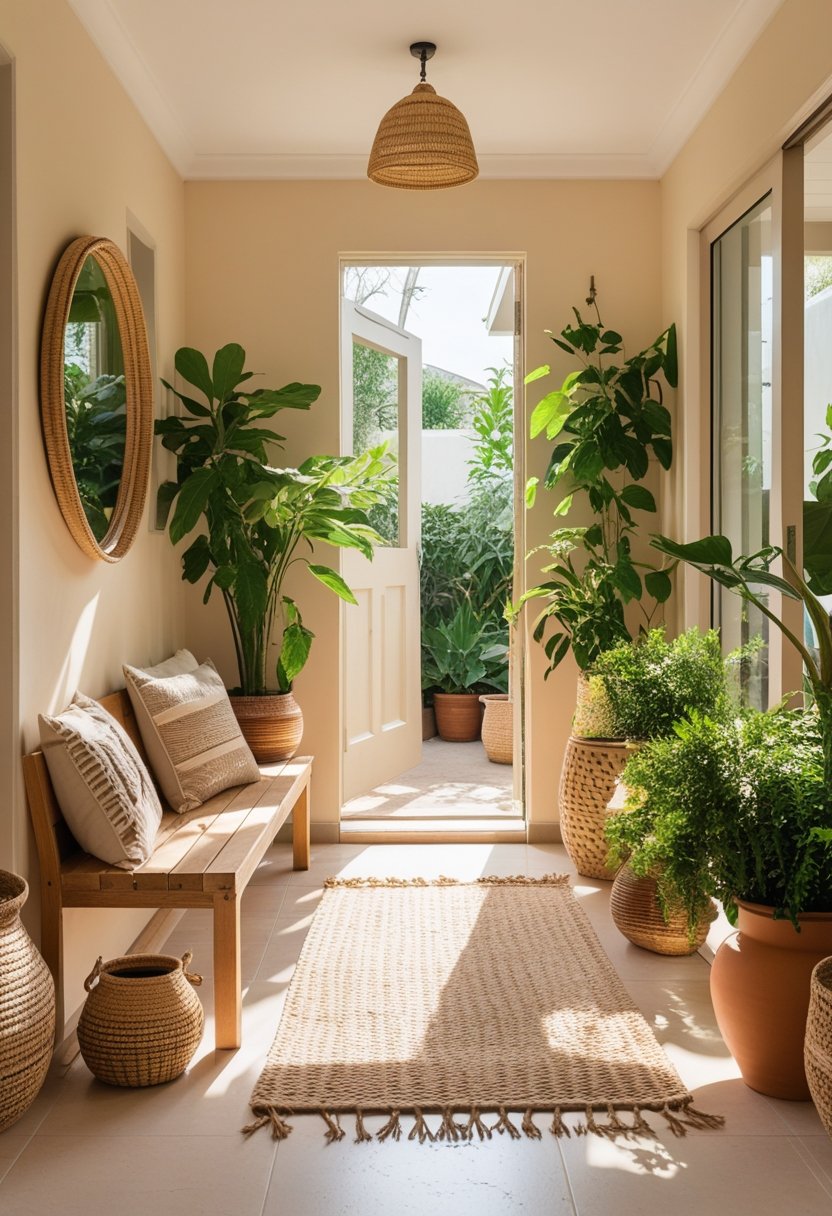
A well-designed entryway balances style with utility, using smart furniture choices and thoughtful organization. It should accommodate everyday needs while maintaining a calm, inviting atmosphere through minimalism and natural elements.
Furnishing for Storage and Organization
Choosing furniture that offers storage without crowding the space is essential. Compact benches with hidden compartments or shelves beneath provide seating and storage simultaneously. Wall-mounted hooks or pegboards keep frequently used items like bags and coats accessible without cluttering surfaces.
Incorporating baskets made from natural fibers enhances storage options and aligns with the boho aesthetic. These can hold shoes, scarves, or other small items.
A small console table with drawers allows for quick stashing of keys and mail. It’s important that furnishings are proportional to the entryway size to avoid congestion, ensuring clear pathways and a spacious feel.
Balancing Minimalism With Practicality
Minimalism in a boho entryway focuses on reducing clutter and emphasizing essential elements. Select a few statement pieces like a woven rug or a large plant to create visual interest without overwhelming the space.
Natural light should be maximized to keep the area bright, which pairs well with neutral tones and organic wood. This approach highlights textures and creates a warm ambiance.
Practicality means avoiding unnecessary accessories that add bulk. Instead, opt for multifunctional decor such as mirror hooks or benches that serve as both seating and storage. This balance maintains the welcoming, airy feel central to modern boho design.

